Katey Schultz's Blog, page 11
February 16, 2015
Revising the Novel: Thoughts on Characterization
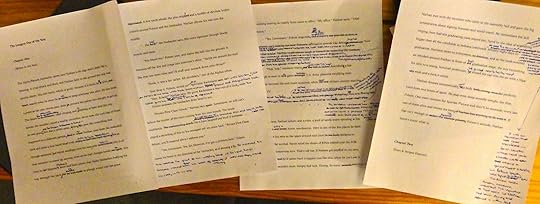 After stalling for about a month, trying to come at painstaking chapters from various different mental states and stages of creativity, I've come to the realization that--while I can (and have been) forcing my way through the final third of the novel in its fourth revision, my heart isnt' in it because I know things about my characters that can no longer be ignored. Their changes aren't manifesting clearly enough in the final third, and in order to do what I want to do there, I need to fix what comes before.
After stalling for about a month, trying to come at painstaking chapters from various different mental states and stages of creativity, I've come to the realization that--while I can (and have been) forcing my way through the final third of the novel in its fourth revision, my heart isnt' in it because I know things about my characters that can no longer be ignored. Their changes aren't manifesting clearly enough in the final third, and in order to do what I want to do there, I need to fix what comes before.I've always charged ahead. Always said I wouldn't obsess and nit-pick to the point of stalling. But working my best angles and trying everything I knew how to do yielded less-than-impressive results in January and February. I wrote about it in my journal. I talked it out with another writer. I pondered and pondered. I even moped. Finally, I accepted that to forgo these revisions of the final third of the novel is not to fail, rather, it's to free myself from writing that I understand will not be true to character anyway.
With that in mind, I sat down in my reading chair, took out my trusty paper and pen, and reviewed some of my favorite quotes from Jeff Vandermeer's astonishing book, Wonderbook. I felt immediately empowered. The work that came in the next few hours was very slow, very meticulous. If someone had been watching me, they might have thought I was simply staring off into space, scribbling just a few lines every ten minutes or so. But there's a reason for this tempo--and it has to do with characterization.
With each line of dialogue, each reaction to setting, each chosen scene--we're characterizing our characters whether we want to or not. Each choice must be exactly right for that character at that time. Each sentence must reflect the proper worldview, and of course, that worldview must evolve and change as the emotional beats of a novel build to a breaking point. Given this, I journaled about the following questions:
How does Nathan (my protagonist) express his desires?How does Nathan feel when those desires are thwarted?What makes Nathan feel relief or happiness?What were Nathan's defining moments as a young man? As a soldier?What is Nathan's greatest fear?What circumstances surrounded the beginning of Nathan's relationship with Tenley? When was the high point of that relationship? When did this relationship experience its first moment of real risk?What setbacks does Nathan face with regard to his desires?What does Nathan have to lose and why?How far will Nathan ignore the truth of his situation before something gives?Is there anyone in the novel who knows something private/secretive about Nathan and can wield that power over him?At its core, what is this novel most essentially about?I found that, with some careful thinking, I was able to answer each and every one of these questions. Most importantly, I believed in those answers. When I came across an answer I didn't believe (or didn't think had manifest in the novel yet), I asked myself why. Then I asked myself how I could fix that, or whether that answer was really the one I should be aiming for in the first place. Finally, I came to the answer to my last question, which I call "the essential sentence":
This novel is about a man's desire to be understood, despite the fact that he can do everything right and still be wrong.
Exhaling for what felt like the firs time in months, I re-read my notes. In my hand I held two scribbled pages of the key to my character. I felt like I knew him, at least a little bit better. This was all the permission I needed to return to the work again, refreshed. I got up from the chair, printed Chapter One, and sat back down. Revision is never best on the computer. The mind and hand, the heart and ethereal, need space to breathe. I read out loud. I repeated sentences. I made notes, changes, additions, subtractions. I crossed things out. Rewrote them. Read things out loud again. In a few hours, I had revised 7 pages, the entirety of my opening chapter.
Slow and steady...I think I can, I think I can, I think I can...
Published on February 16, 2015 05:00
February 12, 2015
Why I Write
 I'm very happy to share the news that Fiction Southeast published an essay I wrote titled "Why I Write." It appeared in their beautiful online magazine this morning. This essay captures some of the sentiments I've wanted to express for several years, and Fiction Southeast seemed the perfect venue.
I'm very happy to share the news that Fiction Southeast published an essay I wrote titled "Why I Write." It appeared in their beautiful online magazine this morning. This essay captures some of the sentiments I've wanted to express for several years, and Fiction Southeast seemed the perfect venue.The essay includes real-time reflections from my book tour, moments of duress, moments of grace, and quotes from respected authors such as Pete Fromm and Barry Lopez. Here's a teaser:
"There’s something bigger going on when we dedicate our lives to story and it has to do with preservation. With loving something—the world, a human being, a sentence—so much, that you can’t stand yourself unless you declare that love in a way others can hear..."
Read the full essay RIGHT HERE.
Published on February 12, 2015 05:00
February 9, 2015
Jogging Writer: Think Like a Miniature Donkey
[So...I took a week off the blog. It happens sometimes. I did start 3 new flash nonfiction pieces, take on a handful of new work, plan my bachelorette party, and get invited to write exhibition content for an art book, though. Oh, and the novel. Yep. It's still there. Still slow. Still steady.]
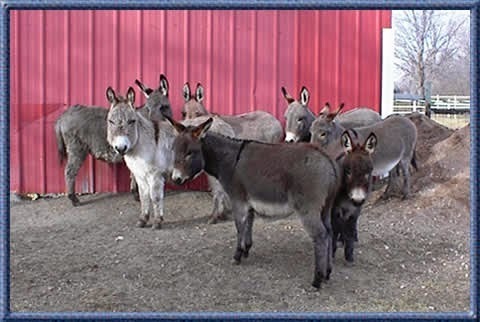 {source}I've finally found a nearby route sufficient for long training runs. When possible, I prefer Bays Mountain Park (35 minutes away, 39 miles of wooded trails), but limited winter hours and lack of my desire for car time typically keep me closer to home on weekends. That means running on Ruritan Run Road in Scott County, Virginia, along with a few winding side roads.
{source}I've finally found a nearby route sufficient for long training runs. When possible, I prefer Bays Mountain Park (35 minutes away, 39 miles of wooded trails), but limited winter hours and lack of my desire for car time typically keep me closer to home on weekends. That means running on Ruritan Run Road in Scott County, Virginia, along with a few winding side roads.
Over the past 4 Sundays, I have successfully learned how to defend myself from zealous dogs, quickened my average pace per mile with each consecutive run, and met some very charming miniature donkeys.
First, the dogs: They're everywhere. At one house in particular, three of them lope down the slope from their owners' trailer, growling and barking like they mean business. The first few times, they actually crossed the road, teeth barred, and followed me. My heart rate monitor watch lit up with numbers skyrocketing. On the way back, I carried rocks and shouted at them--to little effect, though one dog did think the rock might be a treat. In time, I've learned that turning directly toward them, stopping and holding my ground, and settling into a sumo stance will successfully scare them away. The sumo stance is most effective when combined with air boxing and two loud, guttural, NO's.
Second, faster pace: I'm still following Matt Fitzgerald's amazing 80/20 Running book plan and principles, and have combined his training regimen with his recommended nutrition regimen. Ever since trying the Atkins diet a few years back, I haven't felt like I've known how to eat "balanced and normal" again. Fitzgerald's New Nutrition Rules for Marathon and Half-Marathon Runners rescued me...and I still feel like I'm eating a wide variety of foods. Best of all? I don't have to count calories or meticulously weigh portions. Also, I have insight about nutrition while running (for runs longer than an hour or two)--something I'd never had to think about before.
Last, but not least, miniature donkeys: There are more of them than I can count. Ten? Fifteen? I pass them around mile 4 or 5, depending on my starting point, and without fail they will stop in whatever donkey-task they're engaged in and stare at me in utter fixation. It is as though they have never seen a human being before. It is as though I am the Super Bowl, Mickey Mouse, a giant silo of oats. As I approach, one will eventually notice me and stop in his tracks, a few sprigs of hay sticking from his mouth. His friends will soon notice and walk toward the first donkey, until they're all standing in a tight huddle with their eyes locked on mine. "Hey friends!" I've taken to shouting. Stare. Stare. As I pass the barn, more will poke out from the other side, lining up as if by height, so that one small head appears above another until five or six of them have crammed against the outside of the barn to get one last look at this odd, loping, human figure.
All of which is to say, what if those miniature donkeys are onto something? They look at me each time as if anew. I find it refreshing. They don't have any judgement about my pace, my attire, the weather. They're simply there. Looking. Fixated with a newness and curiosity I can only liken to a toddler. It's delightful--and probably worth emulating.
 {source}I've finally found a nearby route sufficient for long training runs. When possible, I prefer Bays Mountain Park (35 minutes away, 39 miles of wooded trails), but limited winter hours and lack of my desire for car time typically keep me closer to home on weekends. That means running on Ruritan Run Road in Scott County, Virginia, along with a few winding side roads.
{source}I've finally found a nearby route sufficient for long training runs. When possible, I prefer Bays Mountain Park (35 minutes away, 39 miles of wooded trails), but limited winter hours and lack of my desire for car time typically keep me closer to home on weekends. That means running on Ruritan Run Road in Scott County, Virginia, along with a few winding side roads. Over the past 4 Sundays, I have successfully learned how to defend myself from zealous dogs, quickened my average pace per mile with each consecutive run, and met some very charming miniature donkeys.
First, the dogs: They're everywhere. At one house in particular, three of them lope down the slope from their owners' trailer, growling and barking like they mean business. The first few times, they actually crossed the road, teeth barred, and followed me. My heart rate monitor watch lit up with numbers skyrocketing. On the way back, I carried rocks and shouted at them--to little effect, though one dog did think the rock might be a treat. In time, I've learned that turning directly toward them, stopping and holding my ground, and settling into a sumo stance will successfully scare them away. The sumo stance is most effective when combined with air boxing and two loud, guttural, NO's.
Second, faster pace: I'm still following Matt Fitzgerald's amazing 80/20 Running book plan and principles, and have combined his training regimen with his recommended nutrition regimen. Ever since trying the Atkins diet a few years back, I haven't felt like I've known how to eat "balanced and normal" again. Fitzgerald's New Nutrition Rules for Marathon and Half-Marathon Runners rescued me...and I still feel like I'm eating a wide variety of foods. Best of all? I don't have to count calories or meticulously weigh portions. Also, I have insight about nutrition while running (for runs longer than an hour or two)--something I'd never had to think about before.
Last, but not least, miniature donkeys: There are more of them than I can count. Ten? Fifteen? I pass them around mile 4 or 5, depending on my starting point, and without fail they will stop in whatever donkey-task they're engaged in and stare at me in utter fixation. It is as though they have never seen a human being before. It is as though I am the Super Bowl, Mickey Mouse, a giant silo of oats. As I approach, one will eventually notice me and stop in his tracks, a few sprigs of hay sticking from his mouth. His friends will soon notice and walk toward the first donkey, until they're all standing in a tight huddle with their eyes locked on mine. "Hey friends!" I've taken to shouting. Stare. Stare. As I pass the barn, more will poke out from the other side, lining up as if by height, so that one small head appears above another until five or six of them have crammed against the outside of the barn to get one last look at this odd, loping, human figure.
All of which is to say, what if those miniature donkeys are onto something? They look at me each time as if anew. I find it refreshing. They don't have any judgement about my pace, my attire, the weather. They're simply there. Looking. Fixated with a newness and curiosity I can only liken to a toddler. It's delightful--and probably worth emulating.
Published on February 09, 2015 05:00
January 29, 2015
The Secret of Superstructures
If it's not evident from the past several posts, my teaching brain is in high gear this month. I'm looking forward to flash fiction in February, a guest lecture and reading at SUNY in March, presentations at AWP in April, ignoring the world in May (wedding!), directing the Writers Retreat & Practicum in June, being a writer-in-residence at Top Secret place part of July, teaching memoir in August, and a deep revision course for ICCA in the fall. Holy cow--did I get all that right? Goodness, it's going to be a big year!
To that end, I've been having a discussion with some of my fellow writing and teaching friends about successful practices in the classroom. I get so fired up about flash fiction, sometimes I worry that I can lose my gauge on the particular needs of a group of participants, risking a missed opportunity with a teachable moment or effective improvisation of my lesson plan. The fact that I'm concerned about this likely means that I'll keep myself in check; all the same--I thought I'd talk briefly about superstructures as a successful entry point for writers of all levels and genres.
After two years on the road and several drafts of Flashes of War, not to mention many isolate months in residencies, it's safe to say that around 2011, my obsession with the flash fiction form started paying off. I felt supercharged by any examples, eager to write as many pieces as I could, and convinced I'd unlocked a few "secrets" of the genre that--whether "secret" or otherwise--have indeed served me well over the years. What I didn't know at the time was that other writers had a name for this secret I was plumbing the depths of and that name was superstructure.
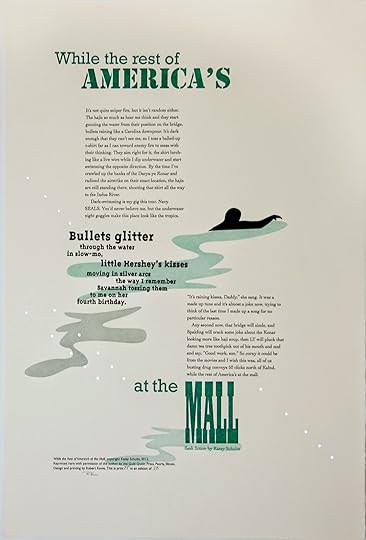 In short, I'd amassed a pile of flash fiction by respectable authors and drafts by my own hand that all followed the same shape--what I now called the "present moment / flashback / present moment" superstructure. No matter the content, no matter the setting, no matter the point of view...if a writer could successfully set up a compelling present moment with a nuanced character, a unique yet relatable yearning or obstacle, and an organic trigger for a flashback, that writer would be more than halfway to a decent, if not compelling, flash fiction. Once the hook was set, the writer then had to efficiently zero in on the most provocative and character-revealing moment or image within that flashback, then lickety-split zoom on outta there and back into the present moment. The result is stories something like this (and artwork like this).
In short, I'd amassed a pile of flash fiction by respectable authors and drafts by my own hand that all followed the same shape--what I now called the "present moment / flashback / present moment" superstructure. No matter the content, no matter the setting, no matter the point of view...if a writer could successfully set up a compelling present moment with a nuanced character, a unique yet relatable yearning or obstacle, and an organic trigger for a flashback, that writer would be more than halfway to a decent, if not compelling, flash fiction. Once the hook was set, the writer then had to efficiently zero in on the most provocative and character-revealing moment or image within that flashback, then lickety-split zoom on outta there and back into the present moment. The result is stories something like this (and artwork like this).
When I teach, I'm aware that I have everyone from MFA graduates to first-time writing course participants in my classroom. I find that mix inspiring, if not also challenging (in a healthy way). Teaching superstructures enables everyone to hit the ground running. The more experienced writers will likely find they can apply more focus to the line-level details of their story even in early drafts. Beginning writers will feel relieved because the structure of the story has been decided for them--freeing them up to focus on the newly learned craft skills pertinent to flash (or whatever genre we're working in at the time). In short, superstructures can help a hyped up teacher keep things in check, assist experienced writers in efficient early drafts, and encourage beginning writers to actually complete a full piece of writing.
My task this month is to name a handful of other superstructures that I find teachable in a weekend flash course. It's something I've intended to articulate for quite some time, and now I have the perfect excuse to do so.
To that end, I've been having a discussion with some of my fellow writing and teaching friends about successful practices in the classroom. I get so fired up about flash fiction, sometimes I worry that I can lose my gauge on the particular needs of a group of participants, risking a missed opportunity with a teachable moment or effective improvisation of my lesson plan. The fact that I'm concerned about this likely means that I'll keep myself in check; all the same--I thought I'd talk briefly about superstructures as a successful entry point for writers of all levels and genres.
After two years on the road and several drafts of Flashes of War, not to mention many isolate months in residencies, it's safe to say that around 2011, my obsession with the flash fiction form started paying off. I felt supercharged by any examples, eager to write as many pieces as I could, and convinced I'd unlocked a few "secrets" of the genre that--whether "secret" or otherwise--have indeed served me well over the years. What I didn't know at the time was that other writers had a name for this secret I was plumbing the depths of and that name was superstructure.
 In short, I'd amassed a pile of flash fiction by respectable authors and drafts by my own hand that all followed the same shape--what I now called the "present moment / flashback / present moment" superstructure. No matter the content, no matter the setting, no matter the point of view...if a writer could successfully set up a compelling present moment with a nuanced character, a unique yet relatable yearning or obstacle, and an organic trigger for a flashback, that writer would be more than halfway to a decent, if not compelling, flash fiction. Once the hook was set, the writer then had to efficiently zero in on the most provocative and character-revealing moment or image within that flashback, then lickety-split zoom on outta there and back into the present moment. The result is stories something like this (and artwork like this).
In short, I'd amassed a pile of flash fiction by respectable authors and drafts by my own hand that all followed the same shape--what I now called the "present moment / flashback / present moment" superstructure. No matter the content, no matter the setting, no matter the point of view...if a writer could successfully set up a compelling present moment with a nuanced character, a unique yet relatable yearning or obstacle, and an organic trigger for a flashback, that writer would be more than halfway to a decent, if not compelling, flash fiction. Once the hook was set, the writer then had to efficiently zero in on the most provocative and character-revealing moment or image within that flashback, then lickety-split zoom on outta there and back into the present moment. The result is stories something like this (and artwork like this).When I teach, I'm aware that I have everyone from MFA graduates to first-time writing course participants in my classroom. I find that mix inspiring, if not also challenging (in a healthy way). Teaching superstructures enables everyone to hit the ground running. The more experienced writers will likely find they can apply more focus to the line-level details of their story even in early drafts. Beginning writers will feel relieved because the structure of the story has been decided for them--freeing them up to focus on the newly learned craft skills pertinent to flash (or whatever genre we're working in at the time). In short, superstructures can help a hyped up teacher keep things in check, assist experienced writers in efficient early drafts, and encourage beginning writers to actually complete a full piece of writing.
My task this month is to name a handful of other superstructures that I find teachable in a weekend flash course. It's something I've intended to articulate for quite some time, and now I have the perfect excuse to do so.
Published on January 29, 2015 05:00
January 26, 2015
Flash Fiction Submission Opportunities
 {source}As I prepare materials to teach my upcoming 10-hour workshop, "What is Flash Fiction and How Can It Improve Short Stories and Novels?" I have taken the opportunity to research flash fiction submission opportunities. This list is in no way exhaustive, rather, it represents publications that I know or have researched to some degree, and would feel confident recommending in a professional, educational setting. I hope most folks will sign up to take my class, but why be stingy? Might as well share that list here, too...and happy submitting!
{source}As I prepare materials to teach my upcoming 10-hour workshop, "What is Flash Fiction and How Can It Improve Short Stories and Novels?" I have taken the opportunity to research flash fiction submission opportunities. This list is in no way exhaustive, rather, it represents publications that I know or have researched to some degree, and would feel confident recommending in a professional, educational setting. I hope most folks will sign up to take my class, but why be stingy? Might as well share that list here, too...and happy submitting!Fiction Southeast Frequently published new material, cutting edge and traditional forms, "big names" and "first timers"--this publication is relatively new to the online literary scene but, having watched it since its inception, I can say with confidence that it hit the ground running and hasn't let up. This is the kind of publication I wish I had time to devour every word of each week...alas. But don't let that stop you from sending them your work--be it flash fiction, flash novels, or even an essay about why you write--they're open to a wide variety and produce and overall professional, clean, respectable website with content your work would find good company in.
The Vestal Review Their claim to fame is that they're the "longest-running flash fiction magazine in the world." A look through past issues and contributors lists will reveal early writings from young flashers of the time who are, now, today's contest judges and award winners. They also review flash fiction collections, and are therefore a handy resources for inspiring publications in the genre.
Smokelong Quarterly About as long as it takes you to smoke one cigarette...that's how long your submission of flash fiction should be to this publication, which has high standards but isn't as inaccessible (or expensive) as something like Glimmer Train. The perk here is that Smokelong works with a rotating editor every week--which means a quick response time to your submission, and that you can cater your submission when the "right" editor comes along. This is truly an invitation to "do your homework," as they say, by finding out who the upcoming editors are, studying their work and aesthetics, and deciding if you think you work is a good match.
Flash: The International Short-Short Story Magazine These folks take a while to respond, but they're every bit worth the wait. When my contributor copies arrived from the UK, I held in my hands a small collection of all flash fiction (or reviews of flash fiction books) that was top-notch. I could have taught a course using the single issue my work appeared in--the variety was that rich and of such caliber. Bonus: If you get accepted, you get to say you are "published internationally." It's also nice to be recognized by a university, and the editors are real human beings with busy lives but an obviously long-standing affinity and taste for the flash form.
Kentucky Review These folks used to be Future Cycle Flash--a magazine and small press. Now they're reincarnated and, while not particularly difficult to get into, still working hard to maintina a high standard for quality flash fiction. Check them out and, especially if you're a first time submitter, send them your work!
The Journal of Compressed Creative Arts These folks are also a small press and often host an annual micro fiction chapbook contest that's worth keeping an eye out for. They publish traditional and experimental forms, are easily digestible, and backed by one of today's top flash fiction authors, editors, teachers, and writers, Randall Brown. Absolutely worth sending them your work!
Prime Decimals This is affiliated with the online magazine called Prime Number, which is further affiliated with Press 53 publishing company. Great content, great variety, great editors, and a highly-motivated, go-get-'em mission that I've seen in action over the past 9 (?) years from various connections. Have at it!
Last but not least, here are a few publications I'm still researching that have recently caught my eye:Litro: http://www.litro.co.uk/submit/Okey Panky: http://okeypanky.comThe List Magazine: https://www.list.co.uk/articles/flash...
Published on January 26, 2015 05:00
January 22, 2015
Flash Fiction & Nonfiction Writing Opportunities
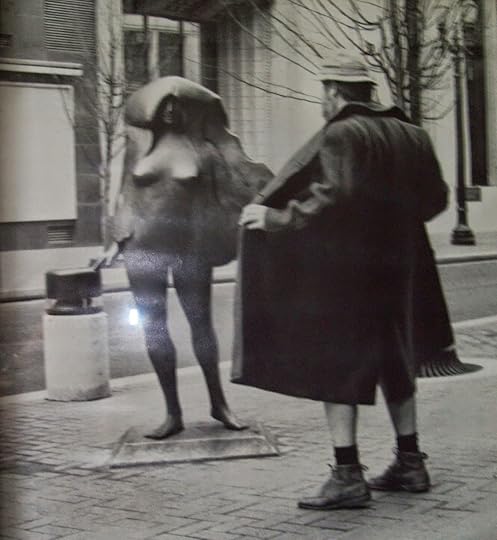 No, not that kind of flasher, silly! Flash writing--as in, 250-750 word stories and memories.
No, not that kind of flasher, silly! Flash writing--as in, 250-750 word stories and memories.I have 6 open spaces in my February offering of Weekly Flashes for fiction or nonfiction writing. Nurture you creative desires with a perfect balance of inspiration, challenge, and coaching by receiving a weekly prompt, reading sample, and critique of your work. We're all human--it's natural to need a little nudge, deadline, or reminder. We're also all busy--and it's easy to cast aside personal goals or professional development in light of pressing priorities. Certainly, kids still need to be fed and bodies still need to be exercised; bills paid and books balanced. But what's an hour a week? Two hours? Consider this an opportunity to generate new work and tap into the quiet reserves of wintertime creativity with help from a pro while you're at it.
The cost of the program is $120. If you sign up and mention that you read about Weekly Flashes on The Writing Life blog, I'll offer a 10% discount for a total of $108. For further details about the program, click here. For other offers, click here. Hope to see you in the flash world!
Published on January 22, 2015 05:00
January 19, 2015
Poems in Winter
What is it about winter that sends me rushing for a piece of paper and pen, breathless with the start of a new poem? During this season, I feel in tune with the sun and stars, enlivened by the air. Space becomes three dimensional, rather than simply what resides within my field of vision. Air can crackle. Water can expand and snap, fall and float--an array of acrobatics! Yesterday, I heard droplets of melting frost trickling down the insides of thick, hollow, bear grass stems. Inside! It reminded me of passing through a field of wildflowers, startling colony after colony of grasshoppers. But here the drip-drop sounds echoed through the cool air, rather than plunking back down to the ground. I leaned in. Listened some more. Indeed--I could hear the water inside--water that had been nothing, merely air, just hours before. Then frost. Then droplets. Now sound. Miraculous!
I cherish these quiet, inward months. The way light bends through the deciduous forest--always a marvel to this Pacific Northwest native. The way the deer grow bold, stretching the minutes of dawn and dusk to get their fill of stems, buds, what more the quiet earth gives. Even the way the roads freeze, creeks icing their way across the ruts; a reminder that there's always more they can take. That even after all the pavement and culverts and flood insurance, humanity is still quite permeable and impermanent. Still quite brittle. Still just as likely to snap off, to tumble down, to rest eternally in nature's bed.
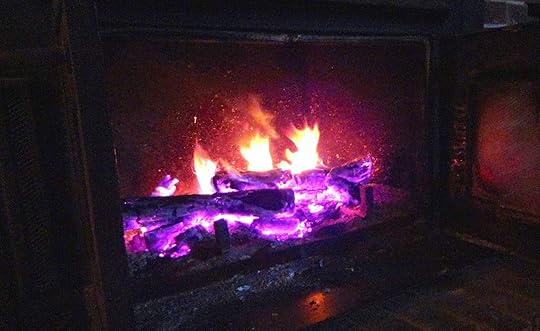 All that being said, maybe I love the cold so much because it gives me an excuse for this...
All that being said, maybe I love the cold so much because it gives me an excuse for this...
I cherish these quiet, inward months. The way light bends through the deciduous forest--always a marvel to this Pacific Northwest native. The way the deer grow bold, stretching the minutes of dawn and dusk to get their fill of stems, buds, what more the quiet earth gives. Even the way the roads freeze, creeks icing their way across the ruts; a reminder that there's always more they can take. That even after all the pavement and culverts and flood insurance, humanity is still quite permeable and impermanent. Still quite brittle. Still just as likely to snap off, to tumble down, to rest eternally in nature's bed.
 All that being said, maybe I love the cold so much because it gives me an excuse for this...
All that being said, maybe I love the cold so much because it gives me an excuse for this...
Published on January 19, 2015 05:00
January 15, 2015
Back into Balance
There are practices we always return to as artists--our "home bases," if you will. The Four-Fifteen has been one such ritual for me. Waking early and keeping the first 2-4 hours of morning in silence is also powerful. During the quiet, I'm filling my well--through meditation, reading, journaling, or writing. Sometimes, I simply walk around the house and look out the windows, or contemplate photographs and notes on my bulletin boards near my writing desk.
Evening is equally important. While I have to fight myself each day to "not go back to work after dinner" (which isn't always possible), it's absolutely worth it each time I let myself do what's best for balance. This often means more reading, more journaling (usually with a glass of wine or spot of bourbon), or letting my mind explore hobbies other than writing. Lately, that's taken the form of reading books about running and proper training for endurance athletes, as well as keeping a logbook of my own training. It's refreshing to let my mind explore other things--not in direct service to my writing, but definitely indirectly essential.
Here's a shot of my "brainstorming" desk. I try my best not to do "paid work" here. Only spiritual reading, journaling, working on the novel, or anything handwritten. My logbook shows months of training and works not only as a record, but a motivator as I track my progress. The Buddhist slogan card reads, "Whichever of the two occurs, be patient." I change these cards out every few days, enjoying the ponderings. What's not shown are any number of coffee table photo books that I like to flip through in the evenings, to relax my mind and eyes.

It's easy to underestimate the strain that starting at a screen in the same position causes on the body. Sometimes I'll take the photo book into the living room and lounge on the couch, aiming for any posture different than the one I keep at my desk. Thumbing through the pages, my eyes can wonder across the colors. These simple movements, because they're different, invite different thoughts--new ideas, and sometimes even new stories.
Evening is equally important. While I have to fight myself each day to "not go back to work after dinner" (which isn't always possible), it's absolutely worth it each time I let myself do what's best for balance. This often means more reading, more journaling (usually with a glass of wine or spot of bourbon), or letting my mind explore hobbies other than writing. Lately, that's taken the form of reading books about running and proper training for endurance athletes, as well as keeping a logbook of my own training. It's refreshing to let my mind explore other things--not in direct service to my writing, but definitely indirectly essential.
Here's a shot of my "brainstorming" desk. I try my best not to do "paid work" here. Only spiritual reading, journaling, working on the novel, or anything handwritten. My logbook shows months of training and works not only as a record, but a motivator as I track my progress. The Buddhist slogan card reads, "Whichever of the two occurs, be patient." I change these cards out every few days, enjoying the ponderings. What's not shown are any number of coffee table photo books that I like to flip through in the evenings, to relax my mind and eyes.

It's easy to underestimate the strain that starting at a screen in the same position causes on the body. Sometimes I'll take the photo book into the living room and lounge on the couch, aiming for any posture different than the one I keep at my desk. Thumbing through the pages, my eyes can wonder across the colors. These simple movements, because they're different, invite different thoughts--new ideas, and sometimes even new stories.
Published on January 15, 2015 05:00
January 12, 2015
Jogging Writer: Reality of Registration
Thirteen miles. It's not a distance I ever thought I'd run. Yesterday, my training took me up to 12 miles and I'd be lying if I didn't say it was hard. Ten miles the week before felt great--I had enough "kick," as they call it, to run hard the last mile and I completed the run with an average of 10min30sec miles. But 12 miles--with my last 1.5 miles being slight, steady uphill, and I wanted to barf for the last 20 minutes. Why? I started too fast, then petered out, resulting in no kick at the end of my run, sorer muscles all around, and an icky feeling all over my body. I started out running my miles in under 10 minutes (not smart), but by the end I could barely keep my miles to 12 minutes. Lesson learned.
 I knew I needed to pace myself to approximately 11-minute miles, but starting off downhill with a bundle of nerves didn't do me any favors. I didn't apply patience, even though I knew what I needed to do. Patience takes energy, and when you're pushing yourself physically, sometimes even mental energy feels like it costs you too much. I guess that's why they call it "training."
I knew I needed to pace myself to approximately 11-minute miles, but starting off downhill with a bundle of nerves didn't do me any favors. I didn't apply patience, even though I knew what I needed to do. Patience takes energy, and when you're pushing yourself physically, sometimes even mental energy feels like it costs you too much. I guess that's why they call it "training."
And now it's official. I've registered for my first Half Marathon, to take place March 28th in Cullowhee, NC at Western Carolina University. It's called the Valley of the Lilies Half Marathon, a name I'm sure is well-intended, but knowing these mountains that time of year there's a good chance it could be 38 degrees and icy. To be fair, perhaps there's equal chance it will be in the upper forties and sunny. In either case, it won't be hot, and that makes me happy.
I've know for a few months that this would probably be the race for me. Due to travel before and after, and cross-referencing those dates with my training schedule, the window of opportunity was fairly narrow. I'm grateful this race is only 2 hours from Celo (albeit it 3 1/2 hours, or so, from Mercy Me). I'll likely spend the night before in a cheap hotel, to avoid having to wake up and drive extra early. Who needs to be folded in half in a car for two hours before trying to run 13 miles? Not me.
I now believe that I can run and finish a 13-mile race. What remains to be seen is if I can run it in a way that makes me feel proud--with an overall healthy pace and enough kick at the end to cross the finish line with dignity.
 I knew I needed to pace myself to approximately 11-minute miles, but starting off downhill with a bundle of nerves didn't do me any favors. I didn't apply patience, even though I knew what I needed to do. Patience takes energy, and when you're pushing yourself physically, sometimes even mental energy feels like it costs you too much. I guess that's why they call it "training."
I knew I needed to pace myself to approximately 11-minute miles, but starting off downhill with a bundle of nerves didn't do me any favors. I didn't apply patience, even though I knew what I needed to do. Patience takes energy, and when you're pushing yourself physically, sometimes even mental energy feels like it costs you too much. I guess that's why they call it "training." And now it's official. I've registered for my first Half Marathon, to take place March 28th in Cullowhee, NC at Western Carolina University. It's called the Valley of the Lilies Half Marathon, a name I'm sure is well-intended, but knowing these mountains that time of year there's a good chance it could be 38 degrees and icy. To be fair, perhaps there's equal chance it will be in the upper forties and sunny. In either case, it won't be hot, and that makes me happy.
I've know for a few months that this would probably be the race for me. Due to travel before and after, and cross-referencing those dates with my training schedule, the window of opportunity was fairly narrow. I'm grateful this race is only 2 hours from Celo (albeit it 3 1/2 hours, or so, from Mercy Me). I'll likely spend the night before in a cheap hotel, to avoid having to wake up and drive extra early. Who needs to be folded in half in a car for two hours before trying to run 13 miles? Not me.
I now believe that I can run and finish a 13-mile race. What remains to be seen is if I can run it in a way that makes me feel proud--with an overall healthy pace and enough kick at the end to cross the finish line with dignity.
Published on January 12, 2015 05:00
January 8, 2015
Winter Song for the Black Mountains
There's something about the uncracked, pre-dawn darkness that motivates me, even on the coldest mornings, to keep my daily ritual of early morning writing. The stars struggle with their ancient light, battling with the moon as it dips behind the rim of the Blacks. Not far behind, pale yellow pours over Seven Mile Ridge, coaxing a snakeline of fog to rise from the river. From one view, the ridgelines are still dark, trees like chopstick silhouettes. From the other, alpenglow thaws the 6000-foot Black Mountain range. Dwarf evergreens frosted in rime ice alight. Through the refraction of light, they appear as ballerinas in shimmery pink, twirling slightly.
The cold front builds with the assuredness of a novel. I go on my longest runs during peak warmth come mid-afternoon--a few miles down the mountain and into the valley, through rhodi thickets and over icy creeks. Oak leaves, a coffee brown carpet across the forest floor. There, a friend takes a photo from his porch and captures the polar vortex as it gathers, high and mighty. My runs take me from halfway up these peaks, into the valley, and to this very spot (then around a loop again):
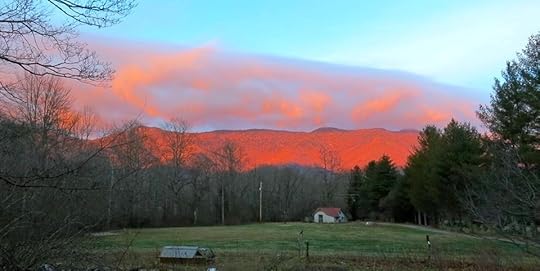 (Courtesy Tal Galton)
(Courtesy Tal Galton)
By nightfall, the "hollers are singing," as they say, meaning the wind whips with such force down the sheer face of the Blacks that it sends a constant sound. Like the ocean waves, if you didn't know better. Tucked into the cabin (not in the Airstream tonight) with locust logs on a slow burn, my muscles carry the cold of the day; a tight memory of hard work, hot breath, miles kicking ice-hard beneath my feet. It feels good to move in body and in words, in views and in time. The sun rises and sets. The mountains sing and sing all night, wind whipping 'round the peaks in subzero furies, curling the clouds in on themselves until they sift free. Move on. Break into a new day.
The cold front builds with the assuredness of a novel. I go on my longest runs during peak warmth come mid-afternoon--a few miles down the mountain and into the valley, through rhodi thickets and over icy creeks. Oak leaves, a coffee brown carpet across the forest floor. There, a friend takes a photo from his porch and captures the polar vortex as it gathers, high and mighty. My runs take me from halfway up these peaks, into the valley, and to this very spot (then around a loop again):
 (Courtesy Tal Galton)
(Courtesy Tal Galton)By nightfall, the "hollers are singing," as they say, meaning the wind whips with such force down the sheer face of the Blacks that it sends a constant sound. Like the ocean waves, if you didn't know better. Tucked into the cabin (not in the Airstream tonight) with locust logs on a slow burn, my muscles carry the cold of the day; a tight memory of hard work, hot breath, miles kicking ice-hard beneath my feet. It feels good to move in body and in words, in views and in time. The sun rises and sets. The mountains sing and sing all night, wind whipping 'round the peaks in subzero furies, curling the clouds in on themselves until they sift free. Move on. Break into a new day.
Published on January 08, 2015 05:00



